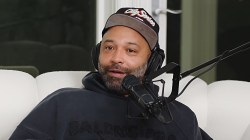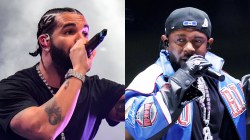In an article recently published on this very site, respected and well-traveled journalist and HipHopDX.com Music Editor Kathy Iandoli made a timely statement on the ideals of wealth and having a successful career as a Hip Hop artist:
“The Rap game is changing. Strike that. The Rap game has changed. We’re living in an era where the wealthy rappers are living lavishly (to the extreme), and directly on the opposite end of the spectrum lies the D.I.Y., blue collar rappers out to make a buck and put it right back into their careers. It’s a weird time, but it’s allowing for the guards to finally change. The big dogs up top are sipping champagne while the rat race below are organizing what the next generation will look like.”
In one simple paragraph, Iandoli summed up exactly where the entire Hip Hop nation stands with regard to artist’s finances, the genre’s continually growing class struggle, and most importantly, just how fragmented the idea of making a good living off of Hip Hop has become. There seems to be an extreme divide between perception and reality that still lingers in Hip Hop’s overall literacy on the topic of money.
The Music Industry And A Stunted Global Economy
Let’s face facts: it’s hard for just about anyone to eek out a living in 2012. In May, the Bureau of Labor Statistics reported the national unemployment rate at 8.2%. That represents about a 1.5% drop from the same time period in 2010, and things weren’t exactly rosey then either. As we continue to digest the reality of a stunted economy that seems to falter and recover almost daily in Obama’s America, having a successful, long-lasting career is getting pretty difficult.

AD LOADING...
That difficulty is also reflected in the music industry, as record and album sales haven’t been a true indicator of artistic success in a long time. The Recording Industry Association of America continues to report the steady decline of physical music sales since the year 2000. Through November 2011, album sales were at 228.5 million, according to Nielsen SoundScan—up 3.3% from the 221.1 million albums sold in the corresponding period of 2010. But that was the first increase since 2004, when physical sales were peaking at an estimated 666 million, according to Reuters.
And even though we’re constantly bombarded with images of major emcees making money hand over fist, driving the latest whips and living the stadium status lifestyle, the majority of Hip Hop artists seem to be living a different reality. Long gone are the days of the unheralded prosperity of the nineties, when just about everyone had the budget for a Hype Williams video. They’ve been replaced with a new millennium Hip Hop industry that’s struggling to keep its artists relevant by any means necessary.
The Impact Of Technology And Mixtapes
I think part of the reason rappers aren’t seeing as many greenbacks these days can also be attributed to how two of the biggest Hip Hop artists of all time—50 Cent and Lil Wayne—revolutionized the mixtape/free music game in their own respective ways. In the early aughts, 50’s strategy of turning a mixtape into a buzzworthy street album and a major marketing tool became a game changer. Later in the decade, Wayne used the infamous “flood the market” approach of releasing several free mixtapes per year, coupled with a ton of collaborations with popular artists across genres. As a result, 50 Cent signed several lucrative deals for his prowess on and off the mic. And Wayne has more or less annually been one of the top sellers. As other artists attempt to repeat 50 and Wayne’s methods, there’s an ongoing debate about whether free projects are creating buzz for retail releases or merely conditioning fans to not have to pay for the product.

AD LOADING...
Emcees such as Drake, Rick Ross, Nicki Minaj, DJ Khaled, Kanye West and others are doing pretty well financially. But for the majority of rappers, the conversation has changed drastically, with peer-to-peer file sharing sites and social media allowing for the seamless sharing of retail projects. Fans can now enjoy as much free music as they want on YouTube and Vevo, while music subscription services such as Spotify are steamrolling the old music business model. All these factors mean there’s more of a distinction between regular everyday emcees and the Forbes “Cash Kings” we see top of the heap in Hip Hop. It also means that rappers have to do more these days to make a decent living. So what’s a rapper to do to get that dollar?
How Artists Diversify Their Earning Power
An obvious symptom of both the continuously evolving, globalized economy and declining physical sales, is that artists at all levels have to work harder than ever. And Cee Lo Green is no exception to the new rule. A New York Times article from December 2011 reveals the following about Cee Lo’s current financial state:
““Forget You,” released in August 2010, reached No. 2 and has sold 5.3 million downloads in the United States, according to Nielsen SoundScan, making it the 12th most downloaded track of all time…A recording contract for an act like Cee Lo would typically offer a net royalty of about 15 percent, according to several music executives. That means that for a $1.29 download from iTunes, after Apple takes its standard 30 percent fee, the artist would be paid 13 or 14 cents; for five million downloads, that amounts to about $650,000. As one of five writers of the song, Cee Lo would also make about $45,000 in publishing royalties on those downloads.”

Yet the Times profile went on to add that Cee Lo was expected to pull down $20 million in 2011. Beyond just being an artist, Cee Lo has made his millions by playing a plethora of different roles: songwriter, producer, TV show personality and host, product spokesperson and touring artist. Basically, Cee Lo had to become an all-around brand as opposed to only being an artist, having had his management company, Primary Wave, create powerful and lasting endorsement deals for him with 7-Up, Absolut Vodka, Fuse TV, and NBC, to name a few.

AD LOADING...
And many rappers are doing that exact same thing. While Lil Wayne sold over 2 million copies of his last outing, Tha Carter IV, he’s also established the Trukfit clothing line featured in Macy’s, and he has an endorsement deal with Mountain Dew. Fellow YMCMB artist Drake has acted as a spokesman for both Sprite and Kodak in the past, while Nicki Minaj is one of the new faces of Pepsi. Similarly, Rick Ross has partnered exclusively with Reebok. The one thing all of these rappers have in common is that they are already at a mainstream level, but they also understand that album sales are only one means of being financially successful. When big global brands come knocking at the doors of record labels and artists, it’s almost a requirement of a rapper these days to abide. But for artists blessed enough to make it to the level of a Cee Lo Green, doing so can potentially lead to a windfall of supplemental income.
Adopting New Methods Of Financial Success
Artists such as Diddy, Jay-Z, 50 Cent, and Dr. Dre have become Hip Hop’s de facto ruling class when it comes to the millions that they rake in, from major endorsement deals. But what about your everyday, emcee just trying to make a buck and either become or remain relevant in such a fickle and fast-paced music economy? While non-retail mixtapes may not directly add to the bottom line, they do provide material that can be useful when it comes to great equalizer for just about all artists—touring.
“A nigga can be brand new, and make nothing but mixtapes,” offered Project Pat, who has both free and retail mixtapes as well as major label releases on his resume. “You’ll have to pay some of these deejays if they don’t know you. But, guess what? They’ll be so hot in the streets that they can put out enough mixtapes and just get that show money. Ain’t nothing wrong with that. You’ll see dudes down here making $8,000 a show and they’re not even on yet.”

AD LOADING...
While touring has been an important source of income for emcees from Project Pat on up to Jay-Z—the latter signed what was essentially a $150 million 360 deal with LiveNation in 2008—there are other methods and standards of financial success within Hip Hop. Brother Ali of Rhymesayers says that most rappers in the world couldn’t dream of getting past the gatekeepers to make it within the confines of the mainstream, but that’s it’s still possible to have a successful career without it.
“I’m in a position where…I made more [money] than my mother for a few years now,” explained Brother Ali. Like many emcees, Ali went the independent route and traded mainstream visibility for increased creative control and royalty splits. “[And] I made more [in 2008] than my dad made. There’s nothing lavish about my lifestyle…I’ve had a daughter [and] I’m married again. My wife stays home with my kids. [We] bought a little house—something that I thought I would never be able to do. And my business associates are some of my closest friends. My deejay is a really good friend of mine…And then I go on tour and my staff and my team that I bring out are all close friends. And the only people that come to the shows are the people who like the music…So my entire life is spent around either people who I love or people who appreciate what I’m doing…I’m living the life that I was meant to live.”
These and many other emcees have found success creating and distributing music independently, or at least outside of the standard model that’s presented day in and day out by mainstream interests. However, for many aspiring emcees, and even some that have already paid major dues in the game, it’s still a difficult pill to dry swallow that money in the Rap game just isn’t what it used to be. And while the current circumstances don’t really make for a future filled with wads of cash.
Misrepresentations Of Wealth In Hip Hop
But it’s quite clear that we as fans are not seeing that fact reflected by some of our favorite artists. Plenty of Hip Hop videos feature artists living the life of a megastar with tons of loot at their disposal without a care in the world. From Nas’ “The Don” to Fat Joe’s “Make It Rain” featuring Lil Wayne, we often see artists presenting a certain lifestyle to the public, even when it’s a known fact that there’s financial trouble brewing for them.

AD LOADING...
It was recently announced that former Roc-a-fella emcee, Beanie Sigel, has been sentenced to two years in prison for failing to file taxes between the years 1999 and 2005. Beanie has admitted that during part of that run he spent upwards of $5,000 per month to finance two Bentleys.

And stories about artists such as Lauryn Hill, Swizz Beats, Bow Wow, Method Man, and others emerge weekly about them having their share of troubles paying taxes. On the song “Superstar,” Hill quipped about working at Foot Locker before plying her trade in the music industry. It’s no secret that many other emcees have gone almost directly from having little to no income at the beginning of their careers to acquiring six and seven figure record label deals. Lil Kim worked at a department clothing store, and Biggie, Nas and many more emcees are on record as having admitted to selling drugs before they got their deals. Therefore, is it honestly that much of a surprise when a Hip Hop artist is at one end of the financial spectrum, but presents themselves as being in an almost completely different and more lucrative set of economic circumstances? Not really. Besides, do fans probably want to support a song or video about how broke a rapper is, how they can’t pay their taxes, and how their house is in foreclosure? Sadly, those issues may be closer to the truth than the extravagance we see portrayed in most videos.
Hopes For Increased Financial Literacy
So in the end, what are the solutions to such a taboo topic? It’s clear that basic financial literacy and sound economic knowledge are still ideals that Hip Hop as a whole still struggles with. And beyond this, they are things that heads across the spectrum just don’t like to talk about.

AD LOADING...
Luckily, Mistah F.A.B. does not fit in that category. While he may floss in videos such as Snoop Dogg’s “Life Of The Party,” he is also candid with fans about fiscal responsibility. F.A.B. often solicits his feature verses and hooks via Twitter. And he displays similar candor when talking about his time at a major label.
“Atlantic gave me a great opportunity, and if I was ready for it, it would have been very lucrative,” F.A.B. said. “I would have lost a lot of money up front, but on the back end I would have gained more. And that’s because they would’ve done more pushing and advertising. They would have put more time into it rather than just giving the money and letting you do what you do. Back then labels were giving you a rope like, ‘Alright. You can either climb to the top or you can hang yourself.’ Thank God for my second wind, networking powers and my ability to stay relevant. I might have messed off the deal and messed off a lot of money, but I didn’t hang myself. I’m still here today.”
There are certain aspects of the Rap industry that are continually misrepresented. Do we honestly know how much an artist on major label makes? Do aspiring emcees and producers know what it takes to start a label? For those that aren’t musically inclined, what about the many different ways to make a living in the industry without just being an artist? And when will labels face the reality of the evolving sales and business models in the industry instead of strictly blaming fans for illegal downloads? I think getting rid of the smoke and mirrors that still cloud Hip Hop’s financial landscape requires us to get serious and get real about these certain truths and myths. If we don’t candidly address this somewhat taboo topic, we’ll all just continue to get cashed in on.
Ron Grant is a freelance writer originally from Detroit and currently residing in Orlando. He has contributed writings to BrooklynBodega.com, PNCRadio.fm and runs two independent music blogs. Follow him on Twitter @RonGreezy.



